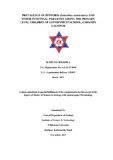Please use this identifier to cite or link to this item:
https://elibrary.tucl.edu.np/handle/123456789/1446| Title: | Prevalence of Pinworm (Enterobius Vermicularis) and other Intestinal Parasites among the Primary Level Children of Government School, Chhampi, Lalitpur |
| Authors: | Khadka, Karuna |
| Keywords: | major health problem;intestinal parasites;parasitic infection.;government school;developing countries |
| Issue Date: | Nov-2017 |
| Publisher: | faculty of zoology |
| Abstract: | Enterobius vermicularis is worldwide in distribution and a major health problem specially among children of developing countries including Nepal. E. vermicularis is detected from perianal region rather than stool sample whereas other intestinal parasites can be collected from stool sample. The present study was carried out to determine the prevalence of E. vermicularis along with other intestinal parasites in the primary level children aged between 2-13 of Shree Chhampi Devi Higher Secondary School, Chhampi, Lalitpur, Nepal. A total of 107 scotch tape (cellophane tape) samples along with stool samples were collected for detection of E. vermicularis and other intestinal parasites. Microscopic examination was conducted for the identification of parasites. Among them, E. vermicularis infection was observed in 10.28% of children with almost equal prevalence in both male and female. Age wise high prevalence was found among the age group 5-7 yrs old (4.67%). The infection rate was not significantly associated with ethnic group (P=0.17), since the prevalence rate was highest in Janajati children (54.54%) compared to others. Itching behavior and nail biting behavior were significantly associated with the prevalence rate of E. vermicularis (P=0.01, P=0.023) respectively. Other intestinal parasites by stool examination revealed five different species of intestinal parasites. Among them, E. coli (27.66%) was the most prevalent protozoan parasite while in case of helminthic parasites, Ascaris lumbricoides (51.06%) was most prevalent followed by Trichuris trichiura (8.51%), Taenia solium (6.38%) and Hookworm (6.38%).The prevalence rate of intestinal parasites showed the significant association with ethnic groups (P=0.00102), knowledge of parents and attitude. Similarly, there were significant association with cleaning vegetables (P=0.015), nail cutting habit (P=0.0001) and use of antihelminthetic (P=0.028). Thus, IPI is still a major health problem among primary level school children and it should be regarded as public health and awareness, sanitation and hygiene practices should be improved. |
| URI: | http://elibrary.tucl.edu.np/handle/123456789/1446 |
| Appears in Collections: | Zoology |
Files in This Item:
| File | Description | Size | Format | |
|---|---|---|---|---|
| final hard copy - Copy.pdf | 1.51 MB | Adobe PDF |  View/Open |
Items in DSpace are protected by copyright, with all rights reserved, unless otherwise indicated.
